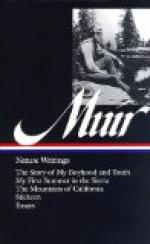Out on the open sandy hills there were a good many thick burly blow snakes, the kind that puff themselves up and hiss. Our Yankee declared that their breath was very poisonous and that we must not go near them. A handsome ringed species common in damp, shady places was, he told us, the most wonderful of all the snakes, for if chopped into pieces, however small, the fragments would wriggle themselves together again, and the restored snake would go on about its business as if nothing had happened. The commonest kinds were the striped slender species of the meadows and streams, good swimmers, that lived mostly on frogs.
Once I observed one of the larger ones, about two feet long, pursuing a frog in our meadow, and it was wonderful to see how fast the legless, footless, wingless, finless hunter could run. The frog, of course, knew its enemy and was making desperate efforts to escape to the water and hide in the marsh mud. He was a fine, sleek yellow muscular fellow and was springing over the tall grass in wide-arching jumps. The green-striped snake, gliding swiftly and steadily, was keeping the frog in sight and, had I not interfered, would probably have tired out the poor jumper. Then, perhaps, while digesting and enjoying his meal, the happy snake would himself be swallowed frog and all by a hawk. Again, to our astonishment, the small specimens were attacked by our hens. They pursued and pecked away at them until they killed and devoured them, oftentimes quarreling over the division of the spoil, though it was not easily divided.
We watched the habits of the swift-darting dragonflies, wild bees, butterflies, wasps, beetles, etc., and soon learned to discriminate between those that might be safely handled and the pinching or stinging species. But of all our wild neighbors the mosquitoes were the first with which we became very intimately acquainted.




